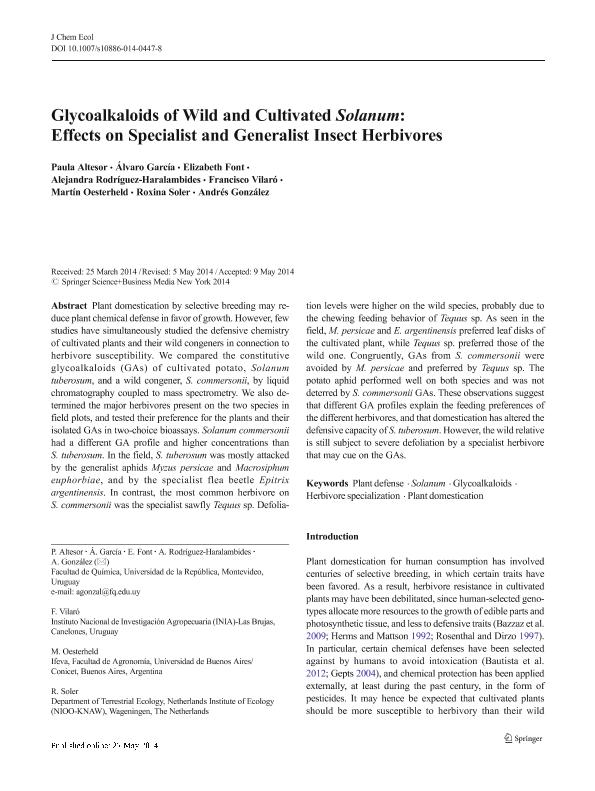Mostrar el registro sencillo del ítem
dc.contributor.author
Altesor, Paula
dc.contributor.author
García, Álvaro
dc.contributor.author
Font, Elizabeth
dc.contributor.author
Rodríguez Haralambides, Alejandra
dc.contributor.author
Vilaró, Francisco
dc.contributor.author
Oesterheld, Martin

dc.contributor.author
Soler, Roxina
dc.contributor.author
Gonzalez, Andres Ramiro

dc.date.available
2016-02-16T20:12:39Z
dc.date.issued
2014-05
dc.identifier.citation
Altesor, Paula; García, Álvaro; Font, Elizabeth; Rodríguez Haralambides, Alejandra; Vilaró, Francisco; et al.; Glycoalkaloids of Wild and Cultivated Solanum: Effects on Specialist and Generalist Insect Herbivores; Springer; Journal of Chemical Ecology; 40; 6; 5-2014; 599-608
dc.identifier.issn
0098-0331
dc.identifier.uri
http://hdl.handle.net/11336/4226
dc.description.abstract
Plant domestication by selective breeding may reduce plant chemical defense in favor of growth. However, few studies have simultaneously studied the defensive chemistry of cultivated plants and their wild congeners in connection to herbivore susceptibility. We compared the constitutive glycoalkaloids (GAs) of cultivated potato, Solanum tuberosum, and a wild congener, S. commersonii, by liquid chromatography coupled to mass spectrometry. We also determined the major herbivores present on the two species in field plots, and tested their preference for the plants and their isolated GAs in two-choice bioassays. Solanum commersonii had a different GA profile and higher concentrations than S. tuberosum. In the field, S. tuberosum was mostly attacked by the generalist aphids Myzus persicae and Macrosiphum euphorbiae, and by the specialist flea beetle Epitrix argentinensis. In contrast, the most common herbivore on S. commersonii was the specialist sawfly Tequus sp. Defoliation levels were higher on the wild species, probably due to the chewing feeding behavior of Tequus sp. As seen in the field, M. persicae and E. argentinensis preferred leaf disks of the cultivated plant, while Tequus sp. preferred those of the wild one. Congruently, GAs from S. commersonii were avoided by M. persicae and preferred by Tequus sp. The potato aphid performed well on both species and was not deterred by S. commersonii GAs. These observations suggest that different GA profiles explain the feeding preferences of the different herbivores, and that domestication has altered the defensive capacity of S. tuberosum. However, the wild relative is still subject to severe defoliation by a specialist herbivore that may cue on the GAs.
dc.format
application/pdf
dc.language.iso
eng
dc.publisher
Springer

dc.rights
info:eu-repo/semantics/openAccess
dc.rights.uri
https://creativecommons.org/licenses/by-nc-sa/2.5/ar/
dc.subject
Plant Defense
dc.subject
Solanum
dc.subject
Herbivore Specialization
dc.subject
Plant Domestication
dc.subject
Glykoalcaloids
dc.subject.classification
Ecología

dc.subject.classification
Ciencias Biológicas

dc.subject.classification
CIENCIAS NATURALES Y EXACTAS

dc.title
Glycoalkaloids of Wild and Cultivated Solanum: Effects on Specialist and Generalist Insect Herbivores
dc.type
info:eu-repo/semantics/article
dc.type
info:ar-repo/semantics/artículo
dc.type
info:eu-repo/semantics/publishedVersion
dc.date.updated
2016-03-30 10:35:44.97925-03
dc.journal.volume
40
dc.journal.number
6
dc.journal.pagination
599-608
dc.journal.pais
Estados Unidos

dc.journal.ciudad
Nueva York
dc.description.fil
Fil: Altesor, Paula. Universidad de la Republica; Uruguay
dc.description.fil
Fil: García, Álvaro. Universidad de la Republica; Uruguay
dc.description.fil
Fil: Font, Elizabeth. Universidad de la Republica; Uruguay
dc.description.fil
Fil: Rodríguez Haralambides, Alejandra. Universidad de la Republica; Uruguay
dc.description.fil
Fil: Vilaró, Francisco. Instituto Nacional de Investigación Agropecuaria; Uruguay
dc.description.fil
Fil: Oesterheld, Martin. Consejo Nacional de Investigaciones Científicas y Técnicas. Oficina de Coordinación Administrativa Parque Centenario. Instituto de Investigaciones Fisiológicas y Ecológicas Vinculadas a la Agricultura; Argentina
dc.description.fil
Fil: Soler, Roxina. Netherlands Institute of Ecology. Department of Terrestrial Ecology; Países Bajos
dc.description.fil
Fil: Gonzalez, Andres Ramiro. Universidad de la Republica; Uruguay
dc.journal.title
Journal of Chemical Ecology

dc.relation.alternativeid
info:eu-repo/semantics/altIdentifier/url/http://link.springer.com/article/10.1007%2Fs10886-014-0447-8
dc.relation.alternativeid
info:eu-repo/semantics/altIdentifier/url/http://dx.doi.org/10.1007/s10886-014-0447-8
dc.relation.alternativeid
info:eu-repo/semantics/altIdentifier/issn/0098-0331
Archivos asociados
